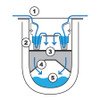Product Description
The 3P Hydro Channel Filter Drains are a linear channel drain combined with multi-level filtration. Ideal for use in SuDs system treatment trains. The 3P Hydro Channel Filter Drain (known as BircoPur in Europe) is able to both mechanically filter coarse solids such as microplastics, leaves, gravels and toehr solids, and then chemically bind pollutants like PAHs, hydrocarbons, heavy metals like Cd, Zn, Cu, Pb as well as phosphate and ammonium. The retained pollutants then can be disposed of easily, legally managed safely with certainty for the end client.
This means that stormwater runoff from highly polluted roads, car parks, yards and industrial areas can be completely treated directly on site and can be drained away or discharged to surface water. An appropriate Mitigation Indice would be 0.9. The Channel Filter from 3P is DiBT certified.
This grated linear drainage filtration system is based on a standard D300mm channel width. Planners and designers do not have to significantly alter the drainage layout if they want to treat the water on site with the space-saving 3P Hydro Filter Drainage channels. This makes it an ideal retrofit option on many sites. Waters can discharge to a green swale or other green infrastructure SuDS option.
Overview of Benefits:
- Modular filtering system for innovative rainwater treatment
- Channel system: NW 300 AS
- With clogging guard
- Massive 4 mm steel frame
- Installed length: 1 and 2 meters
- Load class: A 15 – F 900
- Suitable for high-precipitation area
- Connectable area of 20 sq.m. per running metre of channel
- Assumed rainwater flow: 300 l per sec x ha
Installation sites include:
- Local Authorities
- Commercial users
- Industry
- Private Households
- Parking lots and court yards
How the 3P Hydro Channel Filter Drain (BircoPur) Works:
(see also numbered diagrams above).
- Water comes from the surface to the 3P Hydro Filter Channel Drain.
- The SediBox sedimentation chamber removes coarse solids, such as gravels, microplastics, chippings, leaves and other solids. The rubber seal ensures a water tight seal is maintained. Finer TSS (0 to 200 microns) are removed at this stage.
- The pre-treated water passes through the granular filter bag and the organic and inorganic pollutants including: PAHs, hydroCarbons, heavy metals like Cd, Zn, Cu, Pb as well as phosphate and ammonium are removed.
- The filtered water flows over the baffle into the free flow area of the channel (5).
- The concrete channel moves the water to where it can then be re-used, or discharged to surface or ground water via infiltration.
Trafficked Areas
There are product options for load classes from A 15 to F 900. Contact our Technical Team to discuss your requirements.
Maintenance
(Also see video below).
Maintence is simple and non-specialised.
A visual inspection for damages, general condition and accumulated sediment depth (in the SediBox) should be carried out annually.
If the sediment in the blue SediBox is greater than 57mm the SediBox must be emptied. The rate of accumulation varies between sites and is sometimes up to 10 years.
It is only necessary to replace the Filter Bag after 10 years.
















